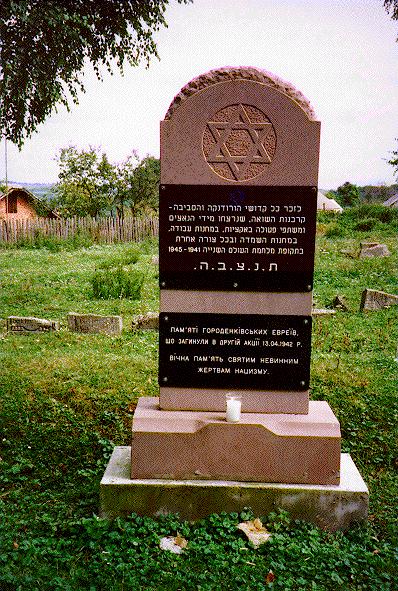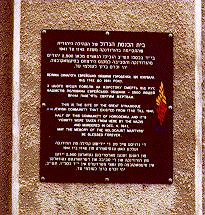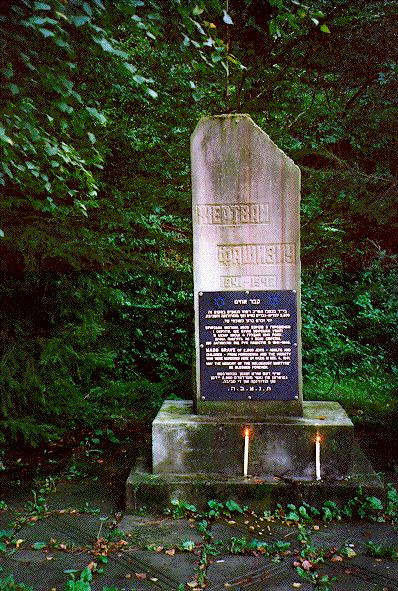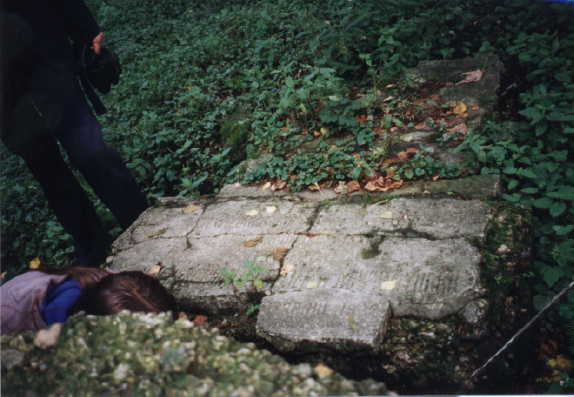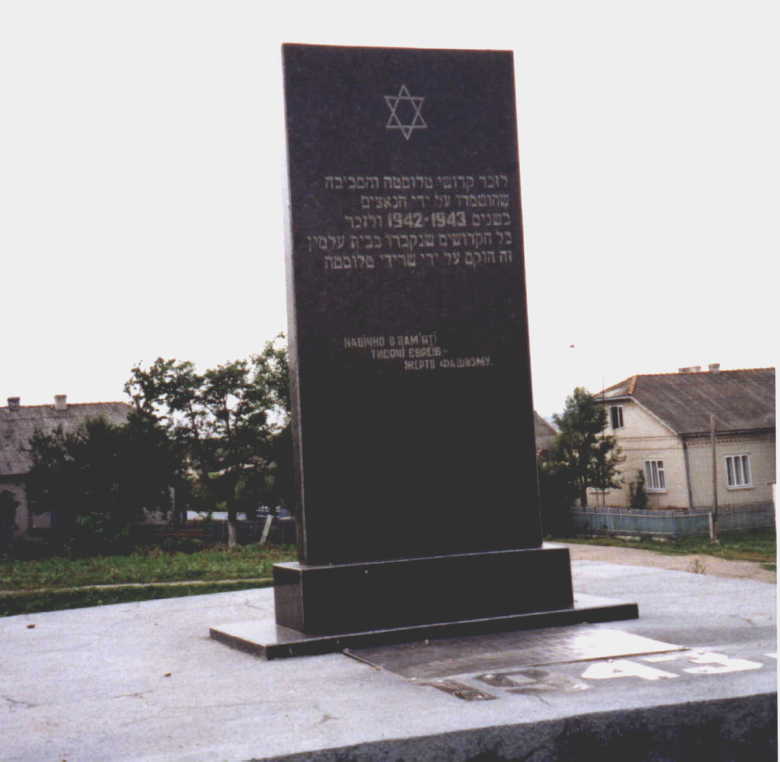 |
||||||||||||||||||||
|
|
||||||||||||||||||||
 |
|
Visiting Horodenka, Fifty-three Years Laterby Tosia Schneider (1997) Over half a century has passed since I walked for the last time on the streets of my hometown of Horodenka. All these years, I longed to return one more time to search for the graves of my family and to try to find out about the fate of my father, Jacob Szechter, who disappeared in the Fall of 1942. In August 1997, my husband and I flew with LOT, Polish Air Line, from Warsaw to Lviv (Lwow, Lemberg), Ukraine. The airport was dreary and rundown. Our passports were checked several times: when we alighted from the plane, when we got off the bus at the terminal, and when the customs control began. A form had to be filled out declaring how much money and other valuables were brought into the country. The customs officials looked quite grim and frequently counted the dollar notes which had been declared. This first introduction to the grayness and depressing atmosphere of Ukraine made me wish to turn around and fly back to Warsaw. A car and driver from the Cheremosh Hotel in Chernivtzy (Czernowitz, Bukovina) waited for us and five hours later we arrived at the hotel. The hotel, less than ten years old, had the necessary amenities, was not particularly well maintained, appeared dark and depressing, and there were lapses in the availability of hot water and several blackouts. The staff, some of whom spoke English, were always very friendly. Through survivors from Horodenka who now live in Israel, I learned about the only Jew who still lives in Horodenka, once the home to over 5,000 Jews. Edik, "the last of the Mohicans", as he refers to himself, picked us up at the hotel and drove us to Horodenka and vicinity. In some parts, the town has changed drastically. On the main street, once lined with Jewish stores, there now stand a few non-descript Soviet-style apartment houses. The streets are in poor condition, as was the case everywhere we visited. Houses built before the war are badly in need of repairs; it seems that little was done for their upkeep, only some additions here and there, to add an extra room.
I was not able to find out, reliably, what had happened to my father, since my mother, my brother, and I had left Horodenka earlier for the Ghetto in Tluste. We were shown at the Horodenka cemetery the graves of some of the last Jews who were brought there and shot by the Germans, so it is possible that this is also my father's last resting place. The Jewish cemetery in Horodenka still exists, though many of the gravestones were removed by the Germans and their local assistants and used to pave the streets. It appears neglected and the overgrown vegetation is checked by grazing animals. The surrounding stone wall is gone, but we were told that the survivors in Israel are planning to have a fence erected. There are two mass graves: one for women and one for men, containing between 62 and 80 people. There is a beautiful memorial over one of the mass graves. It was erected recently by Edik, with the help of survivors in Israel, and has inscriptions in Hebrew and Ukrainian. The Hebrew plaque reads: In memory of all the martyred victims of the Holocaust from Horodenka and vicinity who were murdered by the Nazis and their collaborators during the actions, in the labor camps, in the death camps, and by all other means during the period of the Second World War, 1941 - 1945.
This is the site of the Great Synagogue of the Jewish Community that existed from 1742 till 1941. Half of this community of Horodenka and its vicinity were taken from here by the Nazis and murdered on Dec. 4, 1941. May the memory of the Holocaust Martyrs be blessed forever.
We then drove to Siemakowcze where, on December 4, 1941, 2.500 Jewish men, women, and children were murdered. There, on the mass grave, stands a simple monument, erected some time ago, with the dedication in Russian "To the Victims of Fascism". This was the only inscription which the communist regime would allow. After the demise of the USSR, a tablet was attached describing in Hebrew, Ukrainian, English, and Yiddish what happened on that fateful day: Mass grave of 2,500 Jews - adults and children - from Horodenka and the vicinity who were murdered here by Nazis on Dec. 4, 1941. May the memory of the Holocaust victims be blessed forever. Adjacent to the mass grave is a large camping complex, originally built by the communist trade unions for the vacationing of their members. In recent years, the Jewish Agency had rented this place as a summer camp for Jewish children from throughout Ukraine. I felt uneasy, picturing these Jewish children at play in this terrible place, but also gratified that there were Jewish children here, fifty years after Hitler's violent death. On this late summer day, the place was painfully quiet, the Dniester river flowed as majestically as it probably did on that sad winter day in 1941, and the lush landscape belied the unimaginable horror that happened there, in our generation.... Yes, there still is a town named Horodenka, but for me, the Horodenka of my childhood is to be found only in the far reaches of my memory. Tosia Schneider, born Szechter, spent her early life in Horodenka. She is the only survivor of her family, having spent part of World War II in the ghettoes of Horodenka, Tluste, and the labor camp at Lisowce. She came to the U.S.A. in 1949. She studied at the Hebrew Union College and taught Hebrew for thirty years at Reform religious schools in Morristown, NJ; Augusta, GA; and Atlanta, GA. Her husband of forty-seven years, Alfred Schneider, accompanied her on her visit to Horodenka. He is a professor emeritus of engineering at Georgia Tech and MIT. They have three sons and five grandchildren, and live in Atlanta. More Photos:
A memorial on a mass grave in the Horodenka cemetery, in which 18 Jewish victims of the massacres during the Polish-Ukrainian fighting after WWI are buried. The grave marker was destroyed and was partially reassembled by the only Jewish family now living in Horodenka. The inscription states that the monument was erected in 1932 by the Horodenker Society of New York.
The memorial in the cemetery of Tlusty, where some of the remaining Jews from Horodenka who were sent to and died in the Ghetto of Tlusty (including Tosia’s mother) are buried. The Hebrew inscription reads: In memory of the martyrs of Tlusty and surroundings who were annihilated by the Nazis in the years 1942-1943 and to remember all the martyrs who are buried in this cemetery. Erected by the survivors from Tlusty. |
| [Horodenka] [History and Research] [A Brief History] [Early 1900s Description] [Trip Report (1997)] [Landsmanshaften] [1880-1902 Gazetteer] [1929 Business Directory] [1948 List of Survivors] [Meed Registry] [Dr. Lazar Schneider] [Holocaust Memoir] [Holocaust Tale] [Records] [Maps] [Pictures] [Books] [Message Board] |
